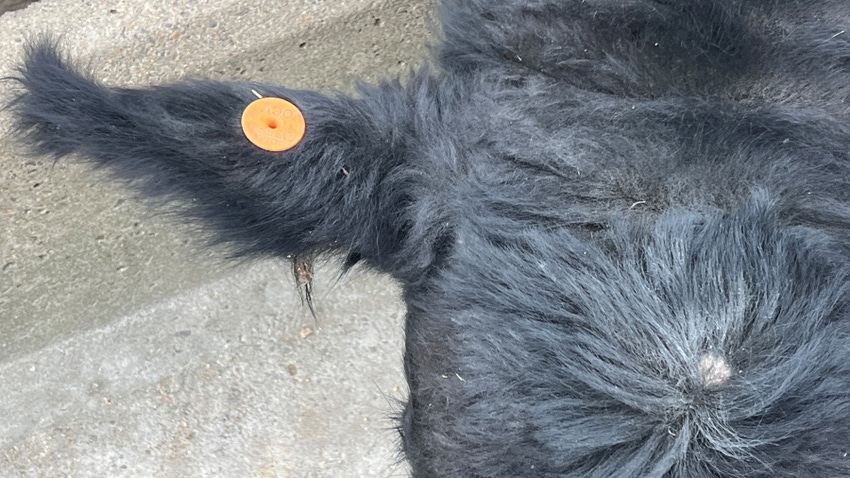February 23, 2023

Traceability has been talked about by livestock producers for several years, especially when discussing the potential threat of a foreign animal disease outbreak. The cattle industry is moving forward to support an animal disease traceability system.
As a result of the National Cattlemen’s Beef Association’s current strategic plan, the traceability working group was formed. The 25-member group was tasked with developing a voluntary, nationally significant, globally accepted, electronic animal disease traceability system for all cattle entering commerce. Todd Wilkinson, NCBA president and chair of the working group, said the group met numerous times putting in hours discussing what is best for the nation’s cattle producers regarding traceability and everything related to it.
“We are making progress on traceability and how it relates to animal disease,” Wilkinson said. “With transportation like it is, the risk is high and real for a foreign animal disease to enter the U.S.” The last time foot-and-mouth disease was found in the U.S. was 1929, but with the current transportation system, a disease like FMD could spread quite quickly — and being able to find the source quickly is important.
“The threat is not necessarily from an animal being shipped in here, but more likely from the bottom of someone’s boots,” he added. “We have to be concerned with how people who say they have been on a farm internationally and aren’t treated any different when they come back here than anyone else. We live in a global society that moves all over, and that’s why there is a sense of urgency to help protect our livestock.”
Traceability program
Wilkinson says the experts continue to tell cattle producers’ leaders that the foreign animal disease risk is real, and the group has set up some important principles to pursue an animal disease traceability program that follows what will work for everyone involved — especially keeping the cattle producer in mind.

GROUP DISCUSSION: Todd Wilkinson, National Cattlemen’s Beef Association president and chair of the traceability working group, discusses the findings of the group and how members worked through many issues during the cattle health and well-being committee meeting at the 2023 Cattle Industry Convention.
“We know a lot of our state health regulators do a great job, but when we are discussing having one state talk to another, that gets more difficult,” he said. “And hearing we may have a two-week gap between the time a disease outbreak is discovered and when we have more control, we need to work faster to not lose our livelihood.”
He said there is some flexibility within the set of principles the working group has set, but it is a great start to get to the end goal of having a program in place to resolve a potential problem.
The group then set goals to be able to move forward. They include:
Establish electronic ID (EID) as the industry standard for individual ID by 2026. This would be the private sector doing this part to make sure it is working quickly.
Gain commitment from other industry stakeholder groups to participate in the EID system by 2024. Wilkinson said groups like the breed associations are ready to move this forward because they have already been working on it. “Producers see this as an insurance policy to be able to protect their herd going forward. It’s giving you insurance that there is a mechanism that can quickly identify an outbreak, have a coordinated effort to deal with it, and not decimate the beef industry,” he said.
Ensure traceability systems are compatible across the United States.
System works
Monte Bordner from Michigan said his state has had mandatory EID for 20 years, “The things I’d like people to consider is, the whole BSE fiasco cost the industry something like $15 billion and took 17 years to get all the markets opened back up.”
Even though the USDA has made the national system voluntary, Michigan premises registration and Michigan Animal Identification System are mandatory to aid in eradication of bovine tuberculosis. Bordner said Michigan sale barns all have readers the cattle go through — and if a problem arises, the animals can be traced back to its origin.
Purebred perspective
Mark McCully, CEO of the American Angus Association, said EID is a means for traceability, “How do we make data collection easier for our breeders? Just recently, our board has chosen to accept electronic identification as a form of permanent identification. It has been a big move for us and is embracing the technology that’s been there.”
He said many Angus members are using the EID and pairing it with data collection, connecting an animal to all its information effectively, efficiently and more accurately at chute-side. The voluntary EID option on purebred Angus cattle requires a USDA 840 tag, which can also be put on the registration paper.
“We want to respect the privacy of the data on the animal, but we want to have this available,” McCully said. “There’s a lot of discussion about how our breeders are using EID to manage their operations. We know our breeders are as time-crunched as ever, and this can help with simplicity of data transmission.”
When it comes to traceability, he said the topic has been discussed for a long time. Producers see the potential threats with foreign animal diseases and there seems to be wide agreement for the need to find the source quickly. McCully said the questions that continue to be asked are who holds the data and who has access to the data and how will it be used?
Policy passed
At the 2023 Cattle Industry Convention, the NCBA board of directors passed a policy for the Support for Enhanced Animal Disease Traceability Systems. This policy is to help state and federal animal health officials respond rapidly and effectively to animal health emergencies, as well as help prevent the introduction of foreign animal diseases.
The policy goes on to follow the beef industry long-range plan to secure the broad adoption of an individual animal ID disease traceability system to equip the industry to effectively manage a disease outbreak, while enhancing both domestic and global trust in U.S. beef.
The agency has also proposed a USDA traceability rule that's open for comments through March 20. This for the use of electronic identification ear tags as official identification in cattle and bison.
Wilkinson said, “As USDA has worked toward a nationally significant animal disease traceability program, NCBA has remained engaged in the conversation with industry stakeholders and USDA to ensure the interest of cattle producers are represented and protected. It is critical that any program ultimately adopted by USDA allows for maximum flexibility and privacy. At the same time, USDA must also minimize the costs for producers and any business disruptions to the industry.”
Burke Healey, senior leader for policy and operation for USDA Animal Plant Health Inspection Service, said once the rules are cleaned up after the comment period and a rule is published, the current metal tags used by veterinarians will be replaced by the electronic ID tags in all cattle and bison.
“If we would have foot-and-mouth disease or another foreign animal disease, we need to think about how fast we can find the animal with the disease and trace any possible spreading,” Healey said.
Wilkinson said the need for bold action is immediate and evident, and NCBA is committed to working with USDA to ensure workable solutions are identified and implemented to help protect the national livestock herd.
“We will ensure it provides maximum producer privacy and flexibility with minimal costs — exactly what our stakeholders have told us they expect from USDA,” Wilkinson said.
NCBA policy
NCBA policy supports a nationally significant animal disease traceability program that should:
Be compatible with private sector animal ID and verification programs backed by the USDA.
Be compatible with the general traceability principles of the World Organisation for Animal Health.
Recognize existing USDA programs for beef exports.
Be built using infrastructure that supports other potential uses of ID.
Use low-cost electronic official tagging devices paid for by federal and/or state funds, when possible.
Require that cattle ID information for disease traceability be kept confidential and strongly protected from disclosure.
Protect ownership information from disclosure to future owners.
Protect producers from liability for acts of others, after the cattle have left the producer’s control.
Operate at the speed of commerce.
Maintain existing state brand inspection activities without replacement or impediment.
Work within a framework to accommodate all classes of cattle.
Allow for separate rule-making process for cattle under 18 months of age.
Allow cattle movement between adjoining states on pasture-to-pasture permits at the discretion of the state animal health officials involved.
Maintain data integrity throughout the system, including retagging and retirement of tags at harvest.
Provide adequate resources to the states to facilitate the objectives of animal disease traceability and include the transition to any electronic identification.
Source: National Cattlemen’s Beef Association
About the Author(s)
You May Also Like






